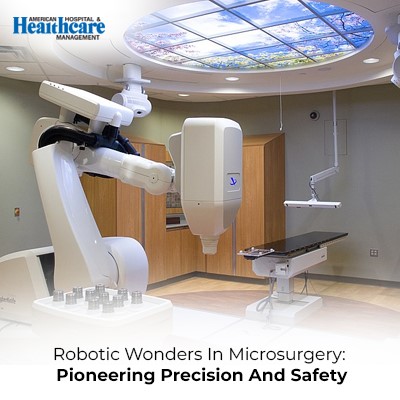This article explores the transformative impact of robotic technology on microsurgery, covering advancements, applications in neurosurgery, ophthalmology, orthopedics, and more. It discusses benefits like precision and reduced fatigue, challenges including cost and training, and future trends like AI integration and nanorobotics, emphasizing patient-centric care and ethical considerations.

Microsurgery has undergone a revolutionary transformation with the integration of robotic technology. Robotic systems have significantly enhanced the precision, accuracy, and safety of microsurgical procedures, leading to improved patient outcomes and expanded possibilities in healthcare. This article delves into the advancements, applications, benefits, and future prospects of robotic wonders in microsurgery.
Robotic microsurgery combines the dexterity of robotic systems with the magnification and precision of microscopes. The evolution of robotic platforms such as the da Vinci Surgical System and the MicroSure system has ushered in a new era of surgical capabilities. These systems feature articulated arms with miniature instruments, advanced imaging technologies, and haptic feedback mechanisms, enabling surgeons to perform intricate maneuvers with unparalleled control.
a. Neurosurgery: Robotic systems have revolutionized neurosurgical procedures by enabling precise tumor resections, delicate nerve repairs, and minimally invasive interventions in the brain and spine. The integration of augmented reality and robotic navigation enhances surgical planning and execution, leading to better outcomes for patients with neurological disorders.
b. Ophthalmology: In ophthalmic microsurgery, robots assist in procedures such as retinal surgeries, corneal transplants, and cataract removal. Robotic platforms offer steady hand movements and high-precision instrument control, reducing the risk of complications and improving visual outcomes for patients with eye conditions.
c. Reconstructive Surgery: Robotic microsurgery plays a vital role in reconstructive procedures, including tissue transplantation, vascular anastomosis, and nerve repair. The ability to perform microsurgeries with robotic assistance enhances graft success rates, accelerates recovery, and minimizes postoperative complications for patients undergoing complex reconstructive treatments.
d. Orthopedics: Robotic systems are utilized in orthopedic microsurgery for precise bone surgeries, joint reconstructions, and spine interventions. Robotic guidance ensures accurate implant placement, optimal alignment, and customized solutions for orthopedic conditions, leading to improved mobility and quality of life for patients with musculoskeletal disorders.
e. Plastic Surgery: Robotic technologies enhance the precision and aesthetics of plastic and reconstructive surgeries, including facial reconstruction, breast augmentation, and tissue flap procedures. Automated suturing and tissue manipulation capabilities improve surgical outcomes, reduce scarring, and enhance patient satisfaction with cosmetic results.
Despite the remarkable advancements in robotic microsurgery, challenges such as cost, training requirements, and integration with existing healthcare systems remain. Future directions in robotic microsurgery include:
Robotic microsurgery is not limited to robotic arms and instruments alone. It integrates seamlessly with other advanced technologies to enhance surgical precision and safety.
a. Imaging Modalities: Robotic systems in microsurgery often incorporate advanced imaging modalities such as intraoperative MRI, CT scans, and 3D reconstructions. These imaging technologies provide real-time visualization of anatomical structures, tumor margins, and critical tissues, aiding surgeons in making informed decisions and optimizing surgical outcomes.
b. Augmented Reality (AR): AR overlays digital information onto the surgeon's view, providing enhanced visualization of surgical targets, instrument trajectories, and vital structures. This technology improves spatial awareness, depth perception, and accuracy during microsurgical procedures, particularly in complex cases requiring precise tissue manipulation.
c. Haptic Feedback: Robotic systems with haptic feedback mechanisms simulate tactile sensations, allowing surgeons to feel tissue resistance, texture, and instrument feedback. This tactile feedback enhances the surgeon's sense of touch and control, facilitating delicate maneuvers and ensuring optimal tissue handling during microsurgery.
d. Navigation Systems: Robotic navigation systems use preoperative imaging data to create 3D maps of patient anatomy, guiding surgeons in planning and executing microsurgical procedures with submillimeter accuracy. These navigation systems enhance procedural efficiency, reduce surgical errors, and contribute to better patient outcomes in microsurgery.
a. Nanorobotics: The development of nanoscale robotic systems holds promise for ultra-precise interventions at the cellular and molecular levels. Nanorobots equipped with sensors, actuators, and drug delivery capabilities could revolutionize targeted therapies, regenerative medicine, and minimally invasive treatments in microsurgery.
b. Surgical Robotics Ecosystem: The integration of robotic microsurgery into a comprehensive surgical robotics ecosystem involves interoperability with electronic health records (EHRs), telemedicine platforms, and data analytics tools. This ecosystem approach streamlines workflow, facilitates data-driven decision-making, and promotes collaborative care in microsurgical settings.
c. Bioinspired Robotics: Inspired by biological systems, bioinspired robotic designs mimic natural movements, structures, and functionalities. Bioinspired microsurgical robots with soft, flexible materials and biomimetic features offer enhanced compatibility with human tissues, reduced invasiveness, and improved patient safety in microsurgery.
As robotic microsurgery continues to advance, ethical considerations regarding patient consent, privacy, and autonomy become increasingly important. Healthcare providers must ensure transparent communication, informed consent processes, and ethical use of patient data in robotic-assisted microsurgical procedures. Additionally, maintaining a patient-centric approach is paramount, focusing on personalized treatment plans, shared decision-making, and holistic care throughout the microsurgical journey.
Robotic wonders in microsurgery epitomize the convergence of cutting-edge technology, surgical expertise, and patient-centered care. By harnessing the power of robotics, advanced imaging, augmented reality, and emerging trends, microsurgeons are pioneering new frontiers in precision, safety, and innovation. The ongoing evolution of robotic microsurgery promises to redefine surgical possibilities, improve patient outcomes, and shape the future of microsurgical excellence worldwide.